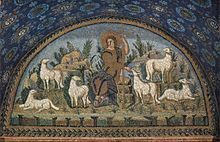'THE GOOD SHEPHERD'
In the earliest Christian art, there are no depictions of Jesus, except symbolically, as the Good Shepherd and others. The Good Shepherd as an image of Jesus persisted until about 500 AD. Mosaic of Christ as the Good Shepherd over the entrance of the Mausoleum of Galla Placidia, dating from around 430 AD.[1] This image was common in the Roman catacombs of earlier centuries, but there are important developments to be seen in this version. Instead of being shown as a typical countryman, this Good Shepherd has a large golden halo, wears a royal purple mantle over a golden tunic, and holds a tall cross. On either side of him are two groups of three sheep, who look peaceful and gaze up at their Shepherd. Christ tenderly touches the nose of one of them. [1]
"I am the good shepherd; I know my sheep and my sheep know me— just as the Father knows me and I know the Father—and I lay down my life for the sheep. John 10:11–18
(NIV):

The 5th-century Ravenna mosaic illustrating the parable.
I have other sheep that are not of this sheep pen. I must bring them also. They too will listen to my voice, and there shall be one flock and one shepherd. The reason my Father loves me is that I lay down my life—only to take it up again. No one takes it from me, but I lay it down of my own accord. I have authority to lay it down and authority to take it up again. This command I received from my Father."
He leads by following, as Jesus said, "the command I received from my Father".[2] He sacrifices Himself to save his sheep: "I lay down my life"[3] The watchman opens the gate for Him. He knows His sheep by name. His sheep know His voice and follow Him voluntarily. He goes before them, making sure the path is safe. There is only one Good Shepherd, Jesus. The rest of us are sheep. Yes, He appoints earthly shepherds (pastors) but these are not "positions", they are gifts from Jesus. These earthly shepherds' whole function is to equip the sheep to serve under one Good Shepherd, one Head, Jesus.[4] This 5th-century Ravenna mosaic illustrates the concept of The Good Shepherd is characterized by religious figures, rich colors and lavish touches of gold that symbolize heaven’s glory. Biblical stories have been transformed into art, which is emphasized through Christ, the Virgin Mary, the saints and the apostles. Abstract and symbolic, these icons were represented with extreme detail and clarity so that the underlying narrative would be apparent.
REFERENCES
[2]Gardner's Art Through The Ages 13th Edition by Fred S. Kleiner
[3]The Bible Gateway
LINKS